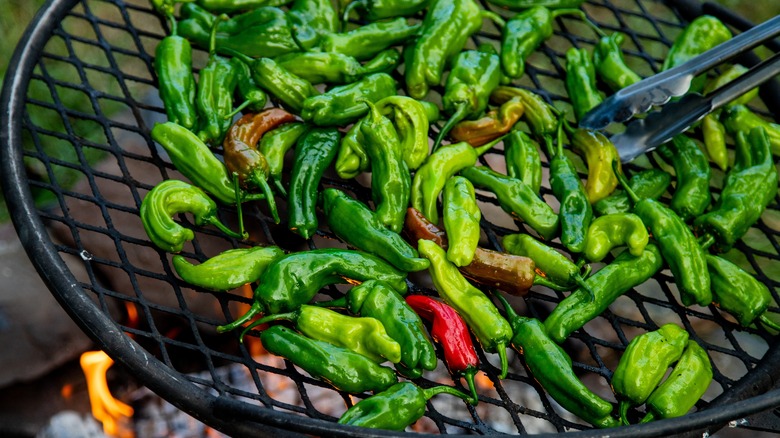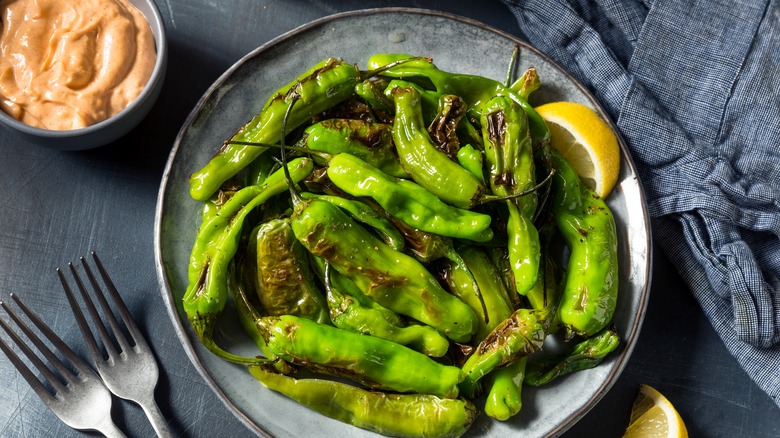How To Cook Shishito Peppers For Perfect Seared Flavor
Shishito peppers have become trendy and sought-after produce in recent years — and for a good reason. Also known as Shishitōgarashi in Japanese, where it originates, they have appeared on menus in many Japanese restaurants and beyond, often served grilled or blistered. These slender, mild chili peppers, usually the size of a finger at its largest, offer a delightful combination of smoky, savory, and slightly sweet flavors. When cooked to perfection, shishito peppers develop a deliciously seared exterior that pairs beautifully with a touch of flaky sea salt.
To enjoy these occasionally spicy peppers — one in ten is spicy, but that gamble is part of the fun (although you can cut the spice out if you desire) — at home, it is important to control the heat you use. While we want the skin of the peppers to blister and blacken slightly, high heat can render these peppers into inedible cinders if we are not careful. It is also important to consider the oil you are using for the task. An oil with high heat tolerance such as canola oil is preferable to one with low heart tolerance such as olive oil. Plus, things like canola are mild and don't interfere with the perfect seared taste you're aiming for. Simply toss them in the pan with oil and sizzle until they develop your desired color.
Tips on roasting shishito peppers
Selecting fresh shishito peppers is the first step in ensuring a delicious outcome. Look for peppers that are vibrant green, smooth, and free from blemishes or wrinkles. Freshness is key to achieving the best flavor and texture. To prep them for searing, clean your peppers by rinsing them under cold water and patting them dry with a kitchen towel. It's essential to ensure they are completely dry before cooking to achieve a good blister. A dry pepper will also prevent excessive splattering and potential injury.
There are a couple of tips to create the perfect blistered shishito pepper other than using that high-heat oil — refined avocado oil or safflower are also great choices. You can toss the peppers in a little oil before adding it to a pan heated to medium-high. Turn them frequently to ensure even roasting. Finally, do not be alarmed if the peppers make popping noises in the pan — this is a sign of the skin blistering. The peppers will cook quickly, so act fast. Once finished, you can season your shishito with flaky sea salt, or several dashes of Japanese chili powder known as shichimi togarashi for a bit of Asian flair.
Use shishito peppers in so many ways
Blistered and slightly charred, seared shishito pepper is a perfect snack to go with a bottle of sake or a cold beer. However, these peppers can also be a component of other dishes. For example, shishito can be used whole as part of a stir fry with pork and beef. The high heat of stir-frying is perfectly suited for the peppers, which bring a hint of spice and crunch.
They also lend themselves well in pickling; their crisp bodies absorb marinades such as soy sauce or kimchi paste for a well-seasoned side dish to go with rice. Speaking of sauces, if you have any blistered peppers left over, you can make a mild salsa by processing them with red onions, tomatoes, garlic, and lime juice. Cut into rings, shishito peppers can be used as you might with any type of sweet peppers. Easy to clean and trim, and more flavorful than regular green bells, shishitos can become your go-to green pepper for any recipe.



